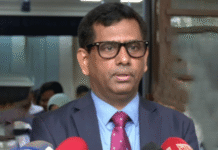
Trucks carrying rice from India waiting to be unloaded at Hili border of Dinajpur. Photo: Prothom Alo
After about 10 years, the Bangladesh government is to import rice from major exporting countries to tackle the immediate crisis.
Rice import is the only way out for the government to keep the rice market stable.
The 4th rice grower Bangladesh is now a major importer, though the government did not import rice over the last four years.
The rice crisis emerged this year after the crops in the haor areas (marshlands) were damaged by heavy rainfall and floods.
The government has reduced import tariff as an incentive for private sector importers.
Efforts made over the past two months have failed out resolve the rice crisis.
In two months, 57,000 tonnes of rice were procured from the international market. The government storehouses, that have a capacity of storing 1.7 million metric tonnes, have only 2,73,000 metric tonnes of rice.
The Directorate of Food has not started selling rice in the open market as yet. Other social safety programmes have been cut.
The food ministry has recently requested the National Board of Revenue to cut import tariff by 5 per cent more in the second phase. As a result, the import price of rice will drop by Tk 1.5 per kg.
Following the latest move, the traders suddenly halted rice import to benefit more although the government is yet to take the final decision.
Unloading of imported rice at land ports has also halted.
On condition of anonymity, officials close to the government said the food ministry delayed in taking the decision to import rice when prices went up in May and June.
NBR delayed till June to take its decision to reduce import tariff in June. Taking opportunity of the tariff cut, traders started importing rice. Unloading of rice at Chittagong and Mongla ports was delayed due to heavy rains in Chittagong and Khulna and so there was no impact of rice prices on the market.
Speaking to Prothom Alo, former adviser to the caretaker government MM Shawkat Ali said the government has to pay if it delays in taking a decision to tackle the crisis. A major crisis may arise out of a minor food crisis due to one natural calamity after another, he said, adding the food ministry has to be made accountable to tackle such crises.
According to the food ministry, the government signed agreements with Vietnam, Thailand and Cambodia to import 3 million tonnes of rice. Discussions are also on to import rice from Myanmar and India.
A contract has been signed with Vietnam to import 2,50,000 metric tonnes of rice.
In a move to import 4,00,000 metric tonnes of rice, the government made a contract to import 3,00,000 metric tonnes of rice through an international tender. Another tender process is about to finish to import 1,00,000 metric tonnes of rice.
Despite so many Memorandums of Understanding (MoUs) and contracts, only 53,000 tonnes of rice imported from Vietnam under the state to state agreement were unloaded at the port in two months. Some 4,700 tonnes of rice through the international tender were unloaded at the port during the same period. As a small amount of rice is imported, it has no impact on the rice market.
According to the food ministry, there is no crisis of rice. The market is under control. The price will fall if the import increases in the days ahead. The government made many agreements to import rice although it earlier claimed that it has a deficit of only 1 million tonnes of rice.
Food minister Quamrul Islam has said, “We are keeping all avenues open so that there will be no crisis in future.”
Rice import under the private sector increased following the decision to cut import tariff from 28 per cent to 10 per cent in June. A number of importers from Dhaka, Khatunganj of Chittagong and Noapara of Jessore, started the import process.
Importers from Chittagong imported rice from Myanmar and Thailand and the traders the other two other areas have also started importing rice.
Crisis after 10 yrs
A similar crisis emerged in 2007-08. Then the price of rice went up to Tk 40 per kilogram as 2.5 million tonnes of rice was damaged by floods.
This time, the price of coarse rice rose to Tk 48 to 50 per kilogram. But it is now being sold at Tk 43 to Tk 45 as import taxes have been relaxed recently while fine rice is being sold at Tk 52 to Tk 60, according to the state-run Trading Corporation of Bangladesh (TCB).
The price of coarse rice increased 38 per cent in just one year.
According to the United States Department of Agriculture (USDA), some 20, 47, 000 metric tonnes of rice were imported in 2007 which is the highest in the country’s rice import history. In 2008, it decreased to 7,32,000 tonnes. Only 70,000 tonnes rice was imported in 2016. However, as much as 7,00,000 tonnes of rice have already been imported during the first half of 2017.
Some 3,45,00,000 tonnes of rice were produced in 2016-17 and it may decrease to 3,41,00,000 tonnes in the current fiscal.
Former director general of the Bangladesh Institute of Development Studies, M Shahabuddin, told Prothom Alo that the government delayed in deciding how much rice would have to be imported after crop damage in the haor floods.
The food ministry must increase its efficiency in view of possible rice crises in future, he added.
This report, originally published in Prothom Alo print edition, has been rewritten in English by Rabiul Islam, and Imam Hossain.
Source: Prothom Alo









